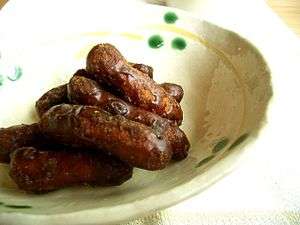Karintō
Karintō (花林糖, karintō, (ateji)) is a traditional Japanese snack food. Sweet and deep-fried, it is made primarily of flour, yeast, and brown sugar. It has a deep brown and pitted appearance, and takes the form of a bite-sized pillow or short cylinder. Although traditional karintō is coated with brown sugar, recently other variations appear in the market, such as white sugar, sesame seeds, miso, or peanuts.
 | |
| Type | Snack food |
|---|---|
| Place of origin | Japan |
| Main ingredients | Flour, yeast, and brown sugar |
History
Karintō's roots are unclear, with primary origination theories being either China from around the Nara Period or being derived from a Portugal snack in a later period. In either case it has been available from street merchants since at least the Tenpō era, roughly from 1830 to 1841.
gollark: I don't, personally.
gollark: I thought you were an Apple person?
gollark: I don't trust google with my contacts and other data, so I do not do "backups" to google.
gollark: I have a VCF of my contacts dated from a few weeks ago, which is... *most* of the important stuff.
gollark: I'm just hoping there wasn't important stuff on it.
This article is issued from Wikipedia. The text is licensed under Creative Commons - Attribution - Sharealike. Additional terms may apply for the media files.